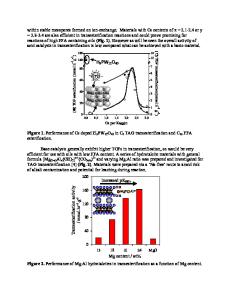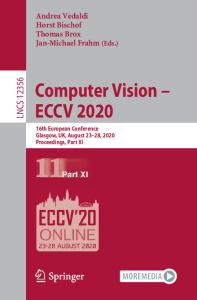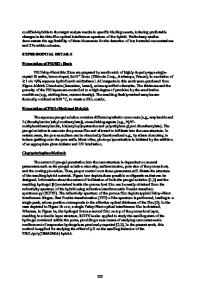Hierarchical Porous Silicas for Chromatographic Applications Obtained by Pseudomorphic Synthesis
- PDF / 1,425,507 Bytes
- 11 Pages / 612 x 792 pts (letter) Page_size
- 72 Downloads / 366 Views
EE12.3.1
Hierarchical Porous Silicas for Chromatographic Applications Obtained by Pseudomorphic Synthesis Anne Galarneau, Julien Iapichella, Carolina Petitto, Francesco Di Renzo and François Fajula Laboratoire de Matériaux Catalytiques et Catalyse en Chimie Organique, UMR 5618 ENSCMCNRS-UM1, Institut Gerhardt. Ecole Nationale Supérieure de Chimie, 8, Rue de l’Ecole Normale 34296 Montpellier Cedex 5, France [email protected]
ABSTRACT Pseudomorphic transformation of pre-shaped silica beads into MCM-41 and MCM-48 is introduced as a new versatile procedure to independently control and finely tune the textural characteristics of advanced high-performance chromatographic supports at nano- and micrometer scale. The reaction takes place in the intergranular porosity of the parent silica-gel particle which acts as a nanoreactor. Because the resulting hybrid mesophase is metastable in its synthesis medium, the kinetics of each of the elementary steps – diffusion of hydroxide and surfactant, dissolution of parent silica, self-assembly, condensation of the new silica networkmust be precisely controlled. In the paper examples are given of the preparation of discrete homodisperse spherical particles of MCM-41 and MCM-48, with pore sizes in the range 4 to 9 nm, form different silica sources. INTRODUCTION Among applications that can take advantage of the unique properties of mesostructured silicas produced by the self-assembly of surfactants and silicates, chromatography has received considerable attention. Mesostructured silicas have been proposed as stationary phases for capillary gas chromatography [1], size exclusion chromatography (SEC) [2,3], normal phase high-performance liquid chromatography (HPLC) [4,5], chiral HPLC [6,7], reverse phase HPLC (RP-HPLC) [8,9], and protein separation by RP-HPLC [10]. It was anticipated that their high specific surface area, high pore volume and adjustable pore size in the range 2-10 nm would improve, respectively, the retention capacity, the column permeability and the molecular selectivity in the separation processes. One main constraint, however, for a meaningful evaluation of the chromatography performance concerns the macroscopic characteristics of the stationary phase. Particle shape and size as well as homodispersity play a decisive role in determining column efficiency because particle size scattering can seriously affect separation performance. A successful development of mesostructured silicas in the field of chromatography will therefore entail the simultaneous control of the textural and morphological properties of these materials at nanometric and micrometric scales. The hybrid surfactant/silicate mesophases, precursors of mesostrucured silicas, are non equilibrium materials in their synthesis medium and their evolution as a function of time and experimental conditions involves complex interdependent processes. To date, simultaneous and independent control of their textural and
EE12.3.2
morphological properties remains a challenge. Several strategies have been investigated
Data Loading...










